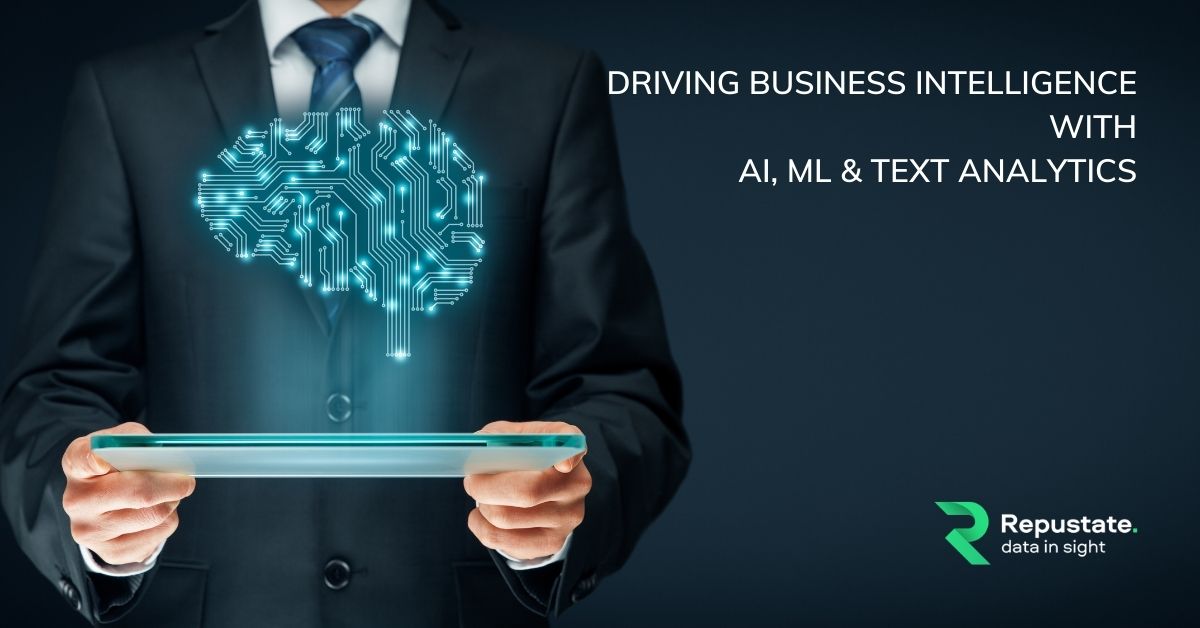How AI, Machine Learning And Text Analytics Drive Business Intelligence
In the era of big data how does a business harness the insights that lie deep within their enterprise data? One of the main ways is to apply artificial intelligence (AI) to text analytics. AI can help you automate the discovery of the most important insights that are hidden in your enterprise data. It can classify it to make it easy to analyze and apply to real world business problems. Specifically, AI text analytics can be used to make the analysis of text data faster, more accurate, and easier to scale. These data insights can be used to drive effective strategic change in operations, marketing, and sales to improve performance and competitive advantage. This information can also be coupled with predictive text analytics to extrapolate on past and present data patterns to help forecast future trending.
What are Artificial Intelligence and Machine Learning?
Artificial intelligence can be best understood by elucidating the meaning of its words - “Artificial” being something made by humans rather than emerging naturally, while “Intelligence” is the ability to learn and apply knowledge. “Knowledge” is information or skills acquired by experience or training. Simply put, Artificial Intelligence, or AI, refers to machines that aspire to copy the basic characteristics of naturally occuring intelligence.
Machine learning (ML) refers to technologies that possess functions that mimic the brain’s ability to learn. Language is one of the basic capabilities of the human brain that artificial intelligence looks to imitate through natural language processing (NLP). NLP is the technical ability for computers to interact with human beings using natural language. NLP is used in the development of recent technologies like speech recognition, text analytics, semantic search and speech-to-text transcription. Repustate uses artificial intelligence powered by machine learning in all it’s semantic technologies including AI text analytics.
How AI and ML supercharge Text Analytics and NLP
Imagine someone asked you to read a page of any book and then tell them in 10 words or less what the page was about. You would probably quickly read the text and try to pick out the most important points and then use them to provide back a brief summary. This is what machine learning when applied to text analytics does, but much faster, more accurately and for millions of documents within seconds. Text analytics is the automated process of extracting the most high value, relevant information from documents and then summarizing them in a way that makes them visual, easy to analyse and much simpler to apply to remedy business challenges. AI supercharges the automated capabilities of computers to read and understand text by utilizing machine learning technologies like ML algorithms, NLP text mining, neural networks, and knowledge graphs.
How do Machine Learning Algorithms work in AI Text Analytics?
A question that many companies ask is how do I apply AI or machine learning to help me drive my text or predictive analytics?
The answer is quite simple. All AI/ML processes follow the same pattern:
- Collect data
- Clean it up
- Train
- Test
- Go back to 2/3 if results are not good enough
Step 1: Collect data
Raw source data must be collected. This could be product reviews, tweets, comments, survey responses whatever.
Step 2: Clean it up
Data needs to be in a machine-readable format (CSV, XLS, JSON) so it can be ingested into any AI training pipeline. One row per data sample. If the training process requires manually pre-tagged data, these tags should also be included in columnar format to make it easy to train. For example, if you’re training for sentiment, column A is the text, column B is the sentiment label, positive or negative
Step 3: Training
The magic happens in step 3. Depending on the algorithm and on the application, it takes many forms. At its core, we’re extracting what are called “features” and trying to correlate features with classifications.
For example, in aspect based sentiment analysis, we extract all important words and phrases using our part of speech tagger, compare the words/phrase to a prebuilt semantic model that knows about word co-occurrence. For example, the words “tasty” and “yummy” often appear in the same places when it comes to food so they must be related somehow. Then we begin to develop a clustering of words from the input corpus.
For classification tasks like sentiment, we figure out which word/phrases/grammatical structures seem to occur in the manually tagged negative or positive samples.
For TikTok text caption identification, we apply yet another training process. We take image frames from TikTok videos, manually annotate a bounding box around the caption, then use optical character recognition (OCR) to convert the image to text.
This is why I say the training process is unique to the task.
Step 4: Testing
Take half your corpus and see how accurate your model is based on training it on the other half. This is called cross-validation.
Step 5: Review
If your results from 4 are too low, you might have to tune some of the training parameters, you might need more data from Step 1, you might need to select more features in Step 3 or ignore some that were causing noise or over-fitting. It’s as much art as it is science.
Conclusion
AI-powered text analytics has become established as the most advanced application of machine learning to data analytics. It is now applied across almost all industries including healthcare, marketing, banking, finance and telecommunications. AI text analytics is now the automated key to decoding the voices of customers, employees and patient experiences. In order for many companies to remain competitive and at the forefront of innovation, it is essential for them to find new ways to apply this essential technology to their day-to-day operations.
 Home
Home
 Feb 10, 2021
Feb 10, 2021

 Jeremy Wemple
Jeremy Wemple
 Dr. Ayman Abdelazem
Dr. Ayman Abdelazem
 Dr. Salah Alnajem, PhD
Dr. Salah Alnajem, PhD
 David Allen
David Allen

 Repustate Team
Repustate Team

